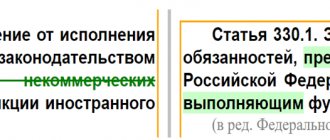The legislation of the Russian Federation, with rare exceptions, prohibits unauthorized cutting down of trees and provides for serious fines for this.
This practice exists not only in Russia, but also in all developed countries, and the penalties there are much higher than ours.
And the stricter the environmental legislation, the larger the fines for illegal tree cutting.
Here we talked about the procedure for obtaining a permit and a felling ticket, as well as about those trees that are not subject to the law, so no fine will be imposed for cutting them down.
Regulatory documents
Despite the fact that most issues related to cutting down or cutting down trees are regulated at the local level, liability for violations is stated in :
- Articles 260 of the Criminal Code (Criminal Code) of the Russian Federation.
- Article 8.28 of the Code of Administrative Offenses (CAO) of the Russian Federation.
These documents apply to any cases of illegal cutting or felling of trees, that is, carried out without obtaining permission from the local administration, that is, they are fined not for cutting down trees, but for lack of permission.
In addition, Article 261 of the Criminal Code of the Russian Federation provides for fines even if the tree was not cut down or cut down, but was damaged in any way, which led to the cessation of its growth. We talked about such methods here.
When can liability be avoided?
Laws regarding deforestation are very weak and have many weaknesses.
For example, a single designation for the term “felling” has not yet appeared. In addition, in a number of regions the interpretation of the law itself differs - some believe that only direct logging is criminally prohibited, and specific participants can be considered guilty, and those who are engaged in related activities are just accomplices. In a number of other regions, on the contrary, all identified persons are considered violators, regardless of what role they played in the process.
It is precisely because of such disagreements in the law that lawyers have a lot of room for maneuver. This practice clearly demonstrates that it is extremely difficult to actually record and then prove a violation, and sometimes it is not at all possible.
For example, timber is not always removed on the same day on which the felling was carried out. In such cases, detainees may claim that they did not cut anything out, but were simply removing abandoned trees.
Both small loggers and gray industrialists take advantage of such imperfections in the system, which is why the scale of illegal logging continues to increase every year.
What determines the severity of the punishment?
Article 8.28 of the Code of Administrative Offenses is valid only when the cost of timber separated from the land does not exceed 5 thousand rubles. In this case, the following plant parameters are taken into account:
- breed;
- age;
- height;
- diameter.
The species affects the unit cost of mature (commercial) wood, and the age determines how much the wood has reached the desired condition, therefore, the younger the plant, the lower the unit price.
The height and diameter of the trunk are used to determine the volume, because the specific cost is calculated in rubles per 1 m3.
The unit cost is set annually , however, in the event of sharp jumps in this parameter on world markets, more frequent recalculation is possible. The same parameters, including unit cost, are also used when calculating payments for obtaining permission to cut down or saw down.
Obtaining permission to cut down
If you intend to cut down or replant trees, you must obtain a so-called “cutting ticket,” which is a permit to carry out the procedure. You can contact him in the following cases:
- during the reconstruction of capital construction projects;
- when carrying out major and current repairs of utilities;
- during demolition of buildings and structures;
- when restoring the standard light regime in residential and non-residential premises;
- when conducting engineering-geological surveys.
Individuals, legal entities, individual entrepreneurs, as well as those authorized to carry out construction can receive a ticket. To obtain a logging permit, the following documents are required:
- statement;
- passport or any other document that identifies the applicant;
- dendroplane;
- a document that identifies the applicant's representative;
- a document that confirms the authority of the representative;
- statement of account.
How is the amount of damage calculated?
What the fine will be depends on the damage caused to nature.
Article 8.28 of the Code of Administrative Offenses applies to situations with minor damage to nature, that is, if the cost of wood separated from the land does not exceed 5 thousand rubles , that is, it is insignificant.
If the cost of all felled trees is 5–50 thousand rubles , then the damage is considered significant and falls under Part I of Article 260 of the Criminal Code of the Russian Federation.
If the damage is 50 - 150 thousand rubles , then it is considered large, therefore it is subject to Part II of Article 260 of the Criminal Code of the Russian Federation. The same article also applies if significant damage was caused as part of a group or through the use of an official position.
If the amount of damage exceeds 150 thousand rubles , then it is considered especially large, and also when large damage is caused by a group by prior conspiracy, Part III of Article 260 of the Criminal Code of the Russian Federation comes into force. This gradation of the degree of damage is prescribed in Article 260 of the Criminal Code of the Russian Federation.
Illegal deforestation 2021 in Russia
Information obtained through space monitoring showed that last year the largest number of illegal logging was organized in the territories of the Siberian and Far Eastern federal districts.
For example, the press service of the Roslesinforg department noted that one of the largest illegal logging operations in Russia in 2020 was discovered in June by specialists from the Pribaikalsky branch of the above-mentioned organization in the Taishet forestry, which is located in the Irkutsk region. More than 117 hectares of forest were damaged.
During the first half of 2021, Roslesinforg specialists identified approximately 7.1 thousand facts of violation of forestry legislation - this is 3% less than the volume of illegal logging for the same period in 2021. The material damage caused by the activities of “black loggers” was estimated by experts at 4.6 billion rubles.
Experts noted these positive changes: if in 2021 there were about 6.6 cubic meters of illegal logging per million hectares of space monitoring, then in 2021 this number dropped to 5.8 cubic meters over the same period of time.
In the country as a whole, the volume of illegal logging in 2021 amounted to 6.3 cubic meters per 1,000 hectares. The overwhelming majority of illegal logging occurred in the Siberian Federal District, in particular 37% of the indicated scale in the Irkutsk region.
In October 2021, Russian Deputy Prime Minister Victoria Abramchenko shared information that annually the rate of decline in Russian forests exceeds their restoration by approximately 450 thousand hectares.
In connection with such unfavorable dynamics, the Russian government decided to develop several key bills aimed at solving the problem of illegal logging.
In accordance with the plan of the Government of the Russian Federation for the decriminalization of the Russian forestry complex, a decision was made to modernize the LesEGAIS system and its subsequent widespread operation. According to the plan, the system will cover all chains of wood movement, from the moment of its extraction at the cutting site to the receipt of the finished product.
Read more about the LesEGAIS system in the article “There will be digitalization: LesEGAIS promises to become mandatory from January 1, 2021.”
The Ministry of Natural Resources and Ecology of the Russian Federation also came up with a bill that envisages the separation of forest supervision and forest protection. Supervision should be completely transferred to the state level.
Another measure to counter the activities of unscrupulous loggers is a ban on the export of unprocessed round timber (round timber) of deciduous and coniferous species. The legislative solution should be implemented next year.
Also in January of this year, the Russian government took the initiative to create a new federal service of forest inspectors, which is provided for in the updated version of the Strategy for the Development of the Country's Forestry Sector until 2030.
Amounts of fines and other types of penalties
We have prepared a table which includes:
- amount of damage;
- the amount of fines without taking into account aggravating circumstances;
- the amount of the fine taking into account aggravating circumstances and their description;
- other types of punishment not related to imprisonment;
- deprivation of liberty.
| Amount of damage | Amount of fine in thousands of rubles, excluding aggravating circumstances | The amount of the fine in rubles, taking into account aggravating circumstances and their description | Other types of punishment not related to imprisonment | Deprivation of liberty |
| Minor | Citizens 3-4, officials 20-40, legal entities 200-300. | Using mechanisms (but not subject to criminal punishment) Citizens 4-5, officials 40-50, legal entities 300-500, plus confiscation of instruments for committing an offense. | ||
| Significant | Up to five hundred or in the amount of salary/income for up to three years. | In a group or using an official position, a fine of 500-1000 thousand rubles or in the amount of salary/income for 18-24 months with a ban on holding certain positions for up to three years. | Up to 480 hours of compulsory labor, up to two years of correctional labor, up to two years of forced labor with a fine of 100-200 thousand rubles or in the amount of salary/income for 12-18 months with a ban on holding certain positions for up to three years.. | Up to two years and a fine of 100-200 thousand rubles or in the amount of salary/income for 12-18 months with a ban on holding certain positions for up to three years. |
| Large | 500-1000 thousand rubles or in the amount of salary/income for 18-24 months with a ban on holding certain positions for up to three years. | By an organized group by prior conspiracy a fine of 1-3 million rubles, or in the amount of salary/income for 4-5 years, up to five years of forced labor with a fine of 300-500 thousand rubles or in the amount of salary/income for 2-3 years with a ban hold certain positions for up to three years. | Up to four years and a fine of 150-300 thousand rubles or in the amount of salary/income for 18-24 months with a ban on holding certain positions for up to three years. | |
| Extra large | 1000-3000 rubles, or the amount of salary/income for 4-5 years. | Up to five years of forced labor with a fine of 300-500 thousand rubles or in the amount of salary/income for 2-3 years with a ban on holding certain positions for up to three years. | Up to seven years and a fine of 150-300 thousand rubles or in the amount of salary/income for 2-3 years with a ban on holding certain positions for up to three years. |
Punishments provided for sleeping in different territories
Despite the fact that fines and criminal liability, as well as other penalties for cutting down a tree, are prescribed in the Code of Administrative Offenses and the Criminal Code of the Russian Federation, situations often arise when it is necessary to turn to other regulations. This is due both to the location of trees in different territories, and to who owns or subordinates the territories.
In the city
Most city trees are located on municipal land, that is, they are the property of the local administration .
This means that each plant must be trimmed and whitened on time, as well as other actions.
An old or dried plant is cut down to protect other trees from a possible source of diseases and pests, and a seedling is planted in its place.
All this is not done for free, because every work must be paid, so additional sanctions are possible for all participants in the illegal cutting of such trees.
Article 1064 of the Civil Code of the Russian Federation states that damage caused to a legal entity, in this case a municipality, must be compensated in full.
It turns out that in addition to a fine or other sanctions for illegal logging, the municipality will also have to reimburse all the expenses it incurs to compensate for the cut down plant, that is:
- growing a seedling;
- transportation to the landing site;
- disembarkation and care until reaching the required age.
a criminal case may be initiated against someone who cut down a tree on municipal land for any purpose under Article 167 of the Criminal Code of the Russian Federation, that is, damage or destruction of someone else’s property.
Taking into account all the expenses that need to be reimbursed to the municipality, the destruction of even one small tree can cause significant damage to property, so there is a high probability of not only receiving a fine, but also imprisonment.
After all, the sanctions under Article 167 are completely similar to those specified in Article 260, however, the division of degrees of damage :
- minor - up to five thousand rubles;
- significant - up to two hundred and fifty thousand rubles;
- large - up to one million rubles.
In the forest
The situation with the forest is different, because the Federal Law “On Amendments to Article 32 of the Forest Code of the Russian Federation” dated April 18, 2018 N 77-FZ allows citizens to collect dead wood for their own needs .
Therefore, theoretically, you can find and cut down a dry leaning tree and not incur liability for it, especially if you cut it into relatively small pieces before exporting it.
However, even in this case, much is left to the discretion of local authorities, so they can establish various prohibitions and restrictions.
If it was not possible to prove that the cut down/cut down plant is dead wood, then very often liability arises under Articles 260 of the Criminal Code of the Russian Federation and 8.28 of the Code of Administrative Offenses of the Russian Federation . That is, depending on the total volume of wood, this can be either a fine from three thousand to three million rubles, or other sanctions, including forced labor or imprisonment.
On your site
Despite the fact that Article 209 of the Civil Code of the Russian Federation gives the owner the right to independently dispose of his property , cutting down a tree on his property without permission may fall under Article 8.28 of the Code of Administrative Offenses of the Russian Federation and 260 of the Criminal Code of the Russian Federation. This happens in cases where a valuable plant is destroyed.
The problem is that the list of valuable breeds is compiled by the local administration, so even in neighboring villages the same breed may turn out to be either of low value, that is, not subject to these articles, or valuable.
If the tree turns out to be a valuable species and the local administration finds out about its cutting, then there is a high probability that fines will be issued based on these articles. A tree 10–50 years old rarely reaches such a volume that the cost of the wood reaches at least the level of significant damage, which involves fines of 3–4 thousand rubles .
If there are several dozen such trees, then the damage may be significant, which is why the fine can reach 500 thousand rubles , and other sanctions are also possible.
We talked in more detail about whether it is possible to cut down trees on your property here.
On someone else's property
If a plant was cut down on someone else’s property, then it is impossible to clearly state the size of the fine or the severity of any other sanctions.
After all, if the owner of the site allowed illegal felling , then responsibility will be divided between him and the one who cut down the tree.
This responsibility is placed on the owner of the plot by Article 32 of the Land Code of the Russian Federation.
If the owner of the plot gave permission for illegal cutting, then this is already an action in a group, that is, an aggravating circumstance. If the cutting was carried out without his consent, then he will have to prove his innocence in court, and this is quite difficult to do.
If the owner of the site informed the police or local administration that illegal logging or sawing is being carried out on his site, then there is a high probability that he will not be considered an accomplice, especially if those who cut down were detained on the spot. However, much will depend on the qualifications of the lawyer whom the owner of the site will entrust to handle this case in court.
In other places
Regardless of the place where the tree grew, various articles of the Criminal Code of the Russian Federation or the Code of Administrative Offenses of the Russian Federation will be applied to those who illegally cut down or felled it, fines and other penalties for which will not be lower than those that we indicated in the table.
There is always a possibility that various aggravating circumstances , due to which fines and other sanctions may be noticeably heavier.
Indeed, in addition to violating the established procedure for obtaining permission, in such situations the interests of third-party individuals and legal entities are affected, which will only add to the claims from law enforcement agencies.
Commentary to Art. 260 Criminal Code
1. The subject of the crime is forest plantings, i.e. trees, shrubs and vines growing in forests, as well as trees, shrubs and vines growing outside forests (for example, plantings in parks, alleys, separately planted trees within the city, plantings in the right of way of railways and highways or canals). In this case, it does not matter whether forest plantations or trees, shrubs, and vines not classified as forest plantations are planted artificially or whether they grew without purposeful human efforts.
In particular, trees, shrubs and vines growing on agricultural lands (with the exception of forest plantations intended to protect lands from the effects of negative (harmful) natural, anthropogenic and man-made phenomena), on personal plots of land, on land plots provided for individual housing, garage construction, personal subsidiary and dacha farming, gardening, livestock and vegetable gardening, in forest nurseries, nurseries of fruit, berries, ornamental and other crops, as well as windfall, windbreaks, dead trees, unless otherwise provided for by special regulatory legal acts. The felling of these plantings, as well as their destruction or damage if there are grounds for this provided by law, can be qualified as theft or destruction or damage to property.
2. The objective side is expressed in illegal logging, as well as damage to the point of stopping the growth of forest plantations or trees, shrubs, and vines not classified as forest plantations.
3. It is illegal to cut down the specified plantings in violation of the requirements of the law, for example, cutting down forest plantations without drawing up the necessary documents (in particular, a lease agreement, a decision on the provision of a forest plot, a forest development project that has received a positive conclusion from a state or municipal examination, a forest purchase and sale agreement plantings, state or municipal contract for the performance of work on the protection, protection, reproduction of forests) either in an amount exceeding the permitted, or in violation of the species or age composition, or outside the cutting area.
4. The crime is considered completed from the moment of commission of any of the listed acts.
5. A mandatory feature is the size of the act committed. Damage caused to forest plantations or trees, shrubs and vines not classified as forest plantations, calculated according to the rates and methods approved by the Government of the Russian Federation, exceeding 5 thousand rubles, is recognized as significant.
How to cut down a tree legally?
Preparations for legal cutting must begin with a visit to the relevant department of the local administration, where you will need to tell about your desire to cut down a particular plant, as well as provide documents for the site and photographs of the trees and surrounding area.
If a plant species turns out to be of little value, the administration will issue an official document about this, after which exactly those plants that were indicated in the application and response from the administration can be cut down without fear of sanctions.
If the rock turns out to be valuable, it will be necessary to conduct an examination, then pay for permission to cut down and carry out restoration measures.
Sanitation measures as a cover for illegal logging
Often, sanitary fellings intended to improve the health of a forest area become a real disaster for it and nearby plantings. Often, documents formalized by law for other types of activities, including sanitary logging, are used as a cover for organizing illegal logging operations.
According to Konstantin Kobyakov, an expert in the Forestry Program of the World Wildlife Fund of the Russian Federation on forests of high conservation value, the main problem lies in the so-called “gray zone”.
This term refers to a situation where documentation for deforestation is present, but it was issued without any reason or, on the contrary, was issued in compliance with all the rules, but in fact the work does not go at all according to plan.
In both cases, healthy forests that are not designated for felling suffer - large volumes of trees of valuable species, often growing completely outside the designated cutting area, fall under the ax of unscrupulous loggers.
The problem of illegal logging under the guise of sanitary and health measures, according to the expert, in the recent past was acute in the Siberian Federal District , namely in the Irkutsk region. Previously, logging for sanitary purposes was carried out there without any valid reason, but by now the situation has managed to level out.
of the Far East suffer from the actions of violating woodcutters , since it is there that such valuable tree species as ash and oak grow. These types of wood are in great demand among buyers abroad, and therefore almost the entire volume of illegally harvested timber is exported. An extremely small percentage of this amount enters the country’s domestic market.
The WWF expert notes that the volume of wood transported through customs is gradually decreasing. If previously the amount of exported valuable timber exceeded the number of issued permits for its felling by 2 or even 5 times, now customs services record a relatively small excess for the transportation of oak, and for ash this percentage is almost completely absent.
The problem of illegal logging has not spared the green wealth of the Caucasus - wood from such valuable species as beech and oak is cut down there with unenviable regularity. However, according to Kobyakov, a small percentage of what is cut down is exported: almost everything is sent for internal processing. Therefore, the scale of illegal logging in the Caucasus is not as great as one would expect, although this still does not cancel the main problem.
Conclusion
Illegal lopping or felling of trees is a serious offense that is subject to not only large fines, but also other sanctions, including forced or correctional labor, as well as arrest .
Therefore, having decided to get rid of a disturbing plant without obtaining permission, it is advisable to ask yourself the question again - is it worth it? After all, a permit can be obtained for money, and the amount of expenses will be many times less than the fine, not to mention other types of punishment.








